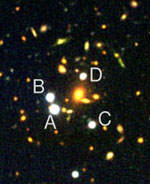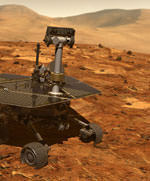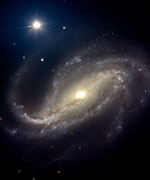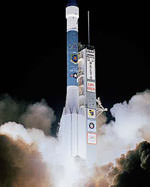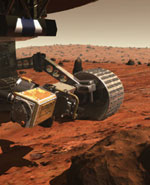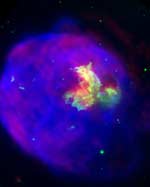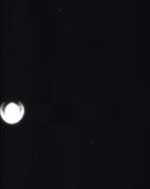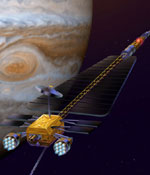
Image credit: NASA/JPL
A new ion engine design, under consideration for NASA’s Jupiter Icy Moons Orbiter mission, has been successfully tested. This was the first performance test of the Nuclear Electric Xenon Ion System, which will use a nuclear reactor to generate electricity for the spacecraft’s ion engine – previous ion engines, like on Deep Space 1 and SMART-1 are solar powered. The new engine operated with 10 times the thrust of Deep Space 1, and should be able to run for 10 years; enough time to visit each of Jupiter’s icy moons which are potential candidates for life.
A new ion propulsion engine design, one of several candidate propulsion technologies under study by NASA’s Project Prometheus for possible use on the proposed Jupiter Icy Moons Orbiter mission, has been successfully tested by a team of engineers at NASA’s Jet Propulsion Laboratory, Pasadena, Calif.
The event marked the first performance test of the Nuclear Electric Xenon Ion System (Nexis) ion engine at the high-efficiency, high-power, and high-thrust operating conditions needed for use in nuclear electric propulsion applications. For this test the Nexis engine was powered using commercial utility electrical power. Ion engines used on the proposed Jupiter Icy Moons Orbiter spacecraft would draw their power from an on-board space nuclear reactor. The ion engines, or electric thrusters, would propel the orbiter around each of the icy worlds orbiting Jupiter — Ganymede, Callisto and Europa — to conduct extensive, close-range exploration of their makeup, history and potential for sustaining life.
“On the very first day of performance testing, the Nexis thruster demonstrated one of the highest efficiencies of any xenon ion thruster ever tested,” said Dr. James Polk, the principal investigator of the ion engine under development at JPL.
The test was conducted on December 12, in the same vacuum chamber at JPL where earlier this year, the Deep Space 1 flight spare ion thruster set the all time endurance record of 30,352 hours (nearly 3.5 years) of continuous operation. The Nexis engine operated at a power level of over 20 kilowatts, nearly 10 times that of the Deep Space 1 thruster, which enables greater thrust and ultimately higher spacecraft velocities for a given spacecraft mass. It is designed to process two metric tons of propellant, 10 times the capability of the Deep Space 1 engine, and operate for 10 years, two to three times the Deep Space 1 thruster life.
Team members working on the Nexis engine also helped develop the first ion engine ever flown on NASA’s highly successful Deep Space 1 mission, which validated 12 high-risk advanced technologies, among them the use of the first ion engine in space.
“The Nexis thruster is a larger, high performance descendant of the Deep Space 1 thruster that achieves its extraordinary life by replacing the metal, previously used in key components, with advanced carbon based materials,” said Tom Randolph, the Nexis program manager at JPL. “The thruster’s revolutionary performance results from an extensive design process including simulations using detailed computer models developed and validated with the Deep Space 1 life test, and other component test data.”
Unlike the short, high-thrust burns of most chemical rocket engines that use solid or liquid fuels, the ion engine emits only a faint blue glow of electrically charged atoms of xenon – the same gas found in photo flash tubes and in many lighthouse bulbs. The thrust from the engine is as gentle as the force exerted by a sheet of paper held in the palm of your hand. Over the long haul though, the engine can deliver 20 times as much thrust per kilogram of fuel than traditional rockets.
Key to the ion technology is its high exhaust velocity. The ion engine can run on a few hundred grams of propellant per day, making it lightweight. Less weight means less cost to launch, yet an ion-propelled spacecraft can go much faster and farther than any other spacecraft.
“This test, in combination with the recent test of the High Power Electric Propulsion ion engine at NASA’s Glenn Research Center, is another example of the progress we are making in developing the technologies needed to support flagship space exploration missions throughout the solar system and beyond,” said Alan Newhouse, director, Project Prometheus. “We have challenged our team with difficult performance goals and they are demonstrating their ability to be creative in overcoming technical challenges.”
NASA’s Project Prometheus is making strategic investments in space nuclear fission power and electric propulsion technologies that would enable a new class of missions to the outer Solar System, with capabilities far beyond those possible with current power and propulsion systems. The first such mission under study, the Jupiter Icy Moon Orbiter would launch in the next decade and provide NASA significantly improved scientific and telecommunications capabilities and mission design options. Instead of generating only hundreds of watts of electricity like the Cassini or Galileo missions, which used radioisotope thermoelectric generators, the Jupiter Icy Moons Orbiter could have up to tens of thousands of watts of power, increasing the potential science return many times over.
Development of the Nexis ion engine is being carried out by a team of engineers from JPL; Aerojet, Redmond, Wash.; Boeing Electron Dynamic Devices, Torrance, Calif.; NASA’s Marshall Space Flight Center, Huntsville, Ala.; Colorado State University, Fort Collins, Colo.; Georgia Institute of Technology, Atlanta, Ga.; and the Aerospace Corporation, Los Angeles, Calif.
For more information about Project Prometheus on the Internet, visit: http://spacescience.nasa.gov/missions/prometheus.htm .
Information on the proposed Jupiter Icy Moons Orbiter mission is available at: NASA Jimo MIssion .
Original Source: NASA/JPL News Release


